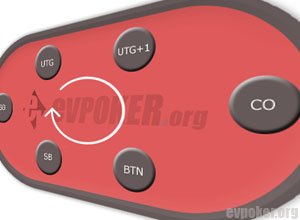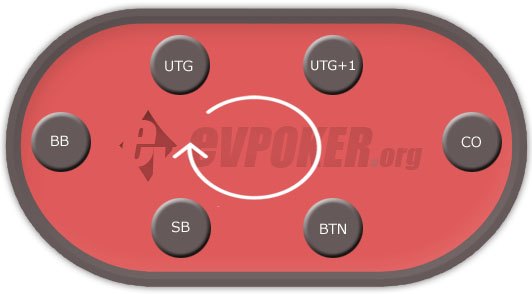Position in poker
 In Texas Hold'em and many other poker games, positions play an important role. Since the game is based on imperfect information, it is normally an advantage to act after the other players because their acting can give a hint about their card holdings.
In Texas Hold'em and many other poker games, positions play an important role. Since the game is based on imperfect information, it is normally an advantage to act after the other players because their acting can give a hint about their card holdings.
Poker variations such as Texas Hold'em and Omaha can be played on tables with different sizes, very common are six and nine places on the table. Regardless which, position will always be important. For a beginner, it's important to understand how the order of action change during a hand before and after the flop is dealt.
Position
If you don’t know about the positions in poker, you will get that explained to you right now. Let’s look at this table including six chairs:

The name of the positions and the clockwise order in poker, illustrated on a 6-max table.
The abbreviations stand for:
UTG - under the gun, the first player to act.
UTG+1 - the next position after under the gun.
CO - cut off, the position before the button
BTN - button, the name derives from the fact that this is the position if a player would deal (a button should lay in front of the dealer).
SB - small blind, this player must post a small blind, a fixed amount of chips
BB - big blind, this player must post a big blind, double the size of the small blind.
This is the names used when referring to positions in poker. The next thing to know about is how the position changes after the flop.
Pre-flop:
Player 1 - UTG, 1st position
Player 2 - UTG+1 2nd position
Player 3 - cut off, 3rd position
Player 4 - the button, 4th position
Player 5 - small blind, 5th position
Player 6 - big blind, 6th position
After the flop (the order changes):
Player 5 - small blind, 1st to act
Player 6 - big blind, 2nd to act
Player 1 - UTG, 3rd to act
Player 2 - UTG+1, 4th to act
Player 3 - cut off, 5th to act
Player 4 - the button, 6th to act
You have to be familiar to these two configurations and plan your game upon it. As you can notice, the player with the button will later become in the position and to be in the position (last to act), is a big advantage. The player in position will have all the information collected when it's his turn to act. If you’re fond of bluffing, this is the bluffing pole position. And, if you're a tight and solid player, playing in position will involve the least risk taking.
This concludes that although the small blind can “limp in” on half the price, he also get the worst position after the flop.
Position yourself correctly at the table
In poker, players act in a clockwise order, meaning the player to your right acts before you. The ideal situation is to have aggressive players acting before you and passive players acting after you.
If you think about it, this makes sense. If raises happen before your turn, you have more information about what it will cost to continue in the hand.
You do not want to waste money in the wrong situations. Even small amounts add up over time. If you call with mediocre cards and the player acting after you raises, you may be forced to fold, wasting your initial investment.
Related articles:
